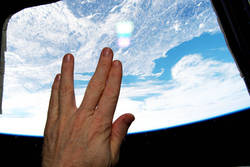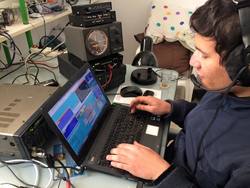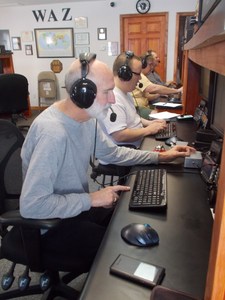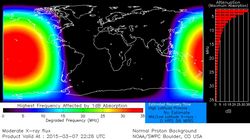 March 11, 2015 Editor: Ward Silver, NØAX | ||||||||
IN THIS ISSUE
NEW HF OPERATORS - THINGS TO DO If you have a taste for digital modes and lively operating, try the North American RTTY Sprint or QRP ARCI Spring Digital Sprints this weekend. You'll wonder where the time went! By the way, the RSGB Commonwealth Contest is only open to amateurs in Commonwealth countries, such as our Canadian readers. BULLETINS Someone has a birthday! While I can't quite claim, "It was twenty years ago today," will thirteen do? The Contest Update, once known as the Contester's Rate Sheet, hit the 'net for the first time on March 13th, 2002. Originally an electronic version of "Contest Corral" plus a little text, it has changed names and grown into a biweekly compendium of shiny things collected by its editor from various bit streams along with a little contest calendar material. The combination seems to work as this is the 339th issue with upwards of 27,000 subscribers who find it invading their Inboxes from time to time. That's all very nice and the response has been great - but it really is time for a change in the editorial department. Have you ever thought you might make a good newsletter editor or reporter? If so, I'd like to hear from you. The ARRL is open for suggestions about where to take the Contest Update in future issues and while you won't have the Jaguar dealer on speed-dial, it does provide some rewards for your efforts. Plus, it gives you a great excuse to do "research" - often confused with "messing around on the Internet." Drop me a note and let's talk! BUSTED QSOS Mike K2MK noticed that the CQ WPX SSB contest on March 28th and 29th is missing from the March QST's Contest Corral. The online PDF has been corrected. Dale N3BNA wrote to let us know that the 4V1JR team operated from the shack of HH2JR in the ARRL DX CW contest, not from the site of the 300-foot tower featured in the previous issue. CONTEST SUMMARY Complete information for all contests follows the Conversation section March 14-15
March 21-22
Two young and interesting DX contests were announced this week. The Nauryz DX Contest is the first and the only Central Asian DX contest on HF. Named for an ancient spring holiday and running on March 14 from 0800-1359Z, the contest promotes HF activity among the Central Asian hams of Kazakhstan, Kyrgyzstan, Uzbekistan, Tajikistan and when ham radio is again authorized there, Turkmenistan. Participants from all over the world are welcome in this third running of the contest. From Africa, Roger ZS6RJ notes that the brand-new Africa All-Mode International DX Contest kicks off next weekend. The everyone-works-everyone contest is a 24-hour, CW/SSB/Digital event sponsored by the SARL starting at 1200Z on March 14th. The 7QAA DXpedition team will be active in the contest as well.(Thanks, Mike UN8GC, and the Daily DX)
Speaking of contest news, the Delaware QSO Party has moved to the first weekend of May which is also home to the big 7QP seventh-district and NEQP first-district regional QSO parties along with the Indiana QSO Party. Whoa! Logging software authors, are you ready? QSO party fans will want to be sure they are ready with the additional county designators and updated programs! In fact, this link is for an online list of state QSO parties maintained by WA7BNM as part of his online contest calendar. (Thanks, Carl KØTNT) And speaking of contest logging software, prolific program purveyor, Scott N3FJP reports the release of three new free packages:
Scott's simple user interface makes getting up to speed on contest logging very easy! Elecraft has announced an upgrade of its synthesizer boards, curing a timing issue (a.k.a. - the "QRQ issue") with the K3. Bob N6TV has prepared an article which shows the on-air improvements provided by the upgrade. Lou van de Nadort PAØLOU, who provided many US and Canadian hams with a first Dutch QSO and many a contest multiplier, died suddenly last Friday. First licensed in 1955 after his service in the Dutch Signal Corps, Lou was an active contester year-in and year-out, particularly on CW, along with holding multiple offices in support of the IARU and its activities. (Thanks, Daily DX)
As wireless electronics grows ever more exotic and the frequencies ever higher, have you ever wondered how the designers test their creations? In fact, how did the wireless pioneers do what they did with the primitive electrical instruments then available. Microwaves & RF columnist, Lou Frenzel W5LEF, muses about this conundrum in his "What Would Tesla Do" column? There are several freshman or sophomore editions of the popular Maker Faires coming up: NoVa Mini Maker Faire (VA): March 15th - 2nd annual If you are in the San Francisco Bay Area and not planning on attending the Dayton Hamvention, check out the biggest Maker Faire of all on the Hamvention's May 16-17 weekend. While you're taking in the sights, find the ham radio booth or consider setting up one yourself at the next opportunity! Web Site of the Week - Bagging a contact with one of the many Antarctic bases is always a thrill during a contest - but how do you count them for multipliers? Luckily, we have two helpful Antarctic information pages to figure it all out. The Clublog Helpdesk offers the Zone Mapping for Antarctica page which even includes a downloadable spreadsheet from IV3TMM which details the many bases and settlements. K6EID has also published a colorful Antarctica Page with maps and images of QSLs received through the years. (Thanks, Daily DX) WORD TO THE WISE Rookie - an old word purportedly derived from the Civil War slang "reckie" for recruits. Various other adaptations are also claimed but in ham radio, it means someone making their first foray into a contest or mode. If you are new to something in ham radio -- and we all are new to something -- look for Rookie categories in contests and award programs! James Brooks 9V1YC has published a collection of his excellent videos of various DXpeditions, including VKØIR, A52A, VP8GEO, VP8THU, FT5XO, ZL8R, K4M, VP8ORK, BS7H, and WRTC2014. I have seen them all, with A52A being my favorite of the DX videos and his WRTC2014 documentary being the best of all WRTC videos. Any of these videos would make for a great club program and all are excellent ways to explain the excitement of DXing and contesting to new hams. (Thanks, Daily DX)
The popular audio program Chat With The Designers by George N2APB and Joe N2CX has returned! The most recent program featured Dave AD7JT discussing measuring a circuit's RF response and his design for a handheld Scalar Network Analyzer (SNA) test instrument. Previous episodes dating back to 2011 are archived and available online. It looks like the December 2014 running of the ARRL 10 Meter Contest broke the record set in 2011 for number of logs received with 5488 submissions! (The 2011 total was 5378.) This reflects the good conditions, increased interest in HF from the year-long ARRL Centennial QSO Party, and nine new categories for ARRL HF contests. While you're busy recovering from the ARRL DX Phone contest, you might also want to check out the January VHF Contest Division records for fixed stations that have been provided by K9JK and line scores for the 10 GHz and Up Contest. The Scandinavian Activity Contest (SAC) Committee of SM5AJV, LB1GB, OH6KZP, and OZ1BII have announced the final results of the 2014 SAC including downloadable PDF awards. Over 2200 logs were submitted on CW and SSB, signifying a healthy SAC! A PDF Results Booklet will be released in the near future, including the tabulated results, soapbox comments, and longer contest stories and photographs collected from a number of SAC participants. Results for the 2014 All-Asia Contest are also available online for both the CW and Phone events. (Thanks, Atsushi JR1NKN)
The project to convert all scores for the complete history of the CQ WW DX Contest into an online database has been completed. In a two-year project led by John N2NC, a team of volunteers typed in all 169,679 SSB and 169,005 CW scores from the results which appeared in CQ Magazine results beginning in 1948. The 2014 results will be added as soon as the results are published. How about a big round of applause for the data entry team of AA4NU, AD1C, JK3GAD, K1EA, K3EST, KB9OWD, N1RR, N3RD, N5DX, NM2O, NO5W, OH6NIO, ON7SS, PD2R, and W2JU? (Thanks, CQ WW Director, Randy K5ZD) One result of having complete data online is this report by Stewart GM4AFF: "A search on Sandy GM3BCL (SK) produces a nice set of results. He never had any massive scores, but he didn't miss one SSB CQWW in 48 years!" OPERATING TIP This week's tip for phone contesting comes courtesy of Jim K9YC - "Use settings in your rig to get rid of as much low frequency (speech) content as you can. The lows burn TX power, but make no contribution to speech intelligibility. I set up my K3 TXEQ for max cut of the three lowest octave bands (50, 100, 200 Hz) and 4-6 dB cut of the 400 Hz band. When I ran FT1000MPs, I set the audio bandwidth for 400-2,600 Hz." You can reset the response for casual operating after the contest. Jim also notes that most ham microphones have a peak in their response around 3 kHz to compensate for rolloff in the SSB filter. A new 50 - 1000 MHz SDR transceiver has been announced by Bruce N6BP and Chris KD2BMH as described in a recent Slashdot article. As Bruce explains, "This radio is unique in that it uses your smartphone for the GUI, uses apps to provide communication modes, contains an on-board FLASH-based gate-array and a ucLinux system. We intend to go for FSF "Respects Your Freedom" certification for the device." Third-generation PC boards are in fabrication to serve as developer boards and later as full-featured transceivers that meet FCC certification requirements.
Discussions of ground radial systems almost inevitably wind up circling around to the classic 1937 paper, "Ground Systems as a Factor in Antenna Efficiency," written by Brown, Lewis, and Epstein of RCA in support of broadcast operation. In case you ever wondered where the "120 radials" standard came from...this is it. The full paper is available online as a PDF for your reference library. (Thanks, Jeremy G3XDK) A couple of neat projects found their way to us this past couple of weeks. The first is a voltage indicator circuit from EDN's "Design Ideas" column that changes the color of LED indicators at a voltage threshold. And I'm sure we all have an old PC hanging around that we haven't recycled - why not breathe a little life into it as shown in this Instructables project? Boom mikes and noise-canceling headphones are always a hot topic in early March for some reason. Probably also in late October! You can purchase the very nice A20 noise-canceling boomset from Bose. The Bose QC15 noise-cancelling 'phones have a mike jack input for mikes like this noise-canceling mike from Headset Buddy or AntLion Audio. Doug K1DG and Don JH5GHM have published online projects showing how to add a boom mike to the QC15, as well. (Thanks, Dave K3ZJ, Peter PC2A, Frank W3LPL) The column "RF Circuit Design References" by Peter Delos in the February edition of High Frequency Electronics is a gold mine of pointers to RF know-how, including a nice mention of the ARRL Handbook. (Thanks, Jim W3KMN) Another excellent free reference was recently released by Texas Instruments - The Analog Engineer's Pocket Reference. Although a little large for a shirt pocket, it's still jam-packed with good information. FAR Circuits sells strips of PC material pads for use with IC sockets in Manhattan-style construction. They are very handy and save a lot of work when you are trying to prototype a circuit using this method. While you're browsing the site, take note of the many projects from QST, the ARRL Handbook, and other ham publications which are supported by circuit boards from Fred and his team. (Thanks, Howard K2UD) What if you could wear electronic sensors on your skin? Would a "selfie" soon refer to a special type of SDR - the Self-Deployed Radio? Dennis N6KI sent us this interesting article about new bio-sensors that would certainly be involved! Technical Web Site of the Week - Like most seriously technical subjects, the discussion on Net Neutrality is somewhat skewed in the popular press. While it sounds simple, nothing involving the Internet's fundamental operation is as easy as it might seem, as detailed in this IEEE Spectrum story on the technical challenges involved. You're Both Right! "It's a dessert topping! It's a floor wax!" So goes the old Saturday Night Live spoof advertisement. A lot of the discussion about the relative merits of using DX spots during a contest or "turning the big knob" has the same aroma about it as the ad. People choose one or the other based on personal experience and preferences honed over years - or decades - of operating.
Recently, I had an interesting opportunity to experience both styles at top-of-the-line stations in the ARRL DX contests. I spent the CW weekend manning 15 meters with Doug K1DG at the western-Pennsylvania K3LR Multi-Multi station. Last weekend's phone edition of the contest found me in Peoria, Illinois with the K9CT team, trying for a W9-district record in Multi-Two. Both weekends were a whole lot of fun (and work)! During the CW weekend, a full complement of Reverse Beacon Network stations running VE3NEA's CW Skimmer software were mainlining many spots per second into the worldwide spotting network. Our stream added spots from a 6-band set of A couple of weeks later found the RBN offline as far as the contest goes. While certain government agencies have no doubt been using automated voice recognition monitoring systems for years, there is no amateur "Phone Skimmer" yet and the hurly-burly of a contest environment would make that a challenging exercise, to say the least. Doctoral thesis, anyone? At K9CT we still had access to spots but they were all human-entered. This dropped the amount of incoming data "considerable" and shifted the non-running operator's job back to continually prowling the waters of the Ionospheric Ocean in search of prey. We depended on others to spot DX stations - presumably after working them - and spotted plenty ourselves in return. As at K3LR, there was no shortage of spots coming in, although not nearly at the volume of the CW weekend. You might expect one source or the other - RBN or human - to have the higher quality. You would be wrong and probably get a lot of log-checking penalties to boot! Both streams of information had issues to be aware of and compensate for. Skimmers are notorious for mistaking various keying artifacts for letters and generating bogus calls. For example, T2NT seemed to be the crowd-pleasing favorite bad spot during the CW contest, a mis-interpretation of N2NT by the software. There were plenty of bad spots generated by humans during ARRL Phone, too: You know, I don't think an unannounced operation from TL5A just happened to be on the same frequency as TO5A!
The same cautions about quality applied to CW and phone spots - don't trust them. Nevertheless, I heard many stations jump right into a pileup after a bad spot was posted, work the station, and vanish. Their LCRs (log checking reports) ought to be fun to read! While CQing was much the same at both stations, the biggest difference was in the duties of the multiplier-hunting station. On CW, I don't think I found more than a handful of stations by tuning around and those were in band segments many skimmers aren't able to tune. The rest of the time, I was trying to wipe that band map spotless. By late Saturday afternoon, I was able to get 'er done but the pristine window never lasted long. Two weeks later, I found myself with one hand continuously dialing, listening and watching the K3's P3 panadaptor for signals, to see if I could "get there" first. After all was said (or sent) and logged, I couldn't really tell you which I found more fun or more challenging. They were different and required different approaches but you still had to be a good operator, alert to incoming information of any sort, and ready to verify all information before logging a contact. Sure, discovering a weak T8 CQing alone on 10 meter phone wouldn't have happened on CW but then, neither would have we managed to work 137 DXCC entities without the automated receivers. I enjoyed both experiences for what they were and applied all of my radio know-how as best I could. There is plenty of room for improvement for me and I'm sure there would be for most of my fellow contesters. If anybody thinks either job is so easy, let them spend a weekend at a big station during good conditions and show us. In the meantime, I think I'll complete the old comedy routine - "You're both right! It tastes terrific - and just look at that shine!" March 11-24, 2015 An expanded, downloadable version of QST's Contest Corral in PDF format is available. Check the sponsor's Web site for information on operating time restrictions and other instructions. HF CONTESTS North American RTTY Sprint--Digital, from Mar 15, 0000Z to Mar 15, 0359Z . Bands (MHz): 3.5-14. Exchange: Both call signs, serial, name, and S/P/C. Logs due: 7 days. Rules RSGB Commonwealth Contest--CW, from Mar 14, 1000Z to Mar 15, 1000Z. Bands (MHz): 3.5-28. Exchange: RST and serial (Commonwealth only). Logs due: 16 days. Rules AGCW QRP Contest--CW, from Mar 14, 1400Z to Mar 14, 2000Z. Bands (MHz): 3.5-28. Exchange: RST, serial, class, AGCW number or NM. Logs due: Mar 31. Rules Louisiana QSO Party--Phone,CW,Digital, from Mar 14, 1400Z to Mar 15, 0200Z. Bands (MHz): 1.8-28, 50,144, CW 1.84,3.54,7.04,14.04,21.04,28.04; Phone 1.865, 3.865, 7.255, 14.255, 21.365, 28.465; VHF 50.095, 50.135, 144.05, 144.21 MHz. Exchange: Call sign, RS(T), LA parish or S/P/C. Logs due: 30 days. Rules QRP ARCI Spring Digital Sprint--Digital, from Mar 14, 1500Z to Mar 14, 1800Z. Bands (MHz): 3.5-28. QRP calling frequencies. Exchange: RST, 4-char grid square, QRP ARCI nr or power. Logs due: 14 days. Rules EA PSK63 Contest--Digital, from Mar 14, 1600Z to Mar 15, 1600Z. Bands (MHz): 3.5-28. Exchange: RST and serial or EA province. Logs due: Mar 31. Rules Tesla Memorial HF Contest--CW, from Mar 14, 1800Z to Mar 15, 0800Z. Bands (MHz): 3.5. Exchange: RST, serial, and 4-char grid square. Logs due: Mar 20. Rules QCWA Spring QSO Party--Phone,CW,Digital, from Mar 14, 1800Z to Mar 15, 1800Z . Bands (MHz): 1.8-28, 50. Exchange: Call,year lic'd,name,QCWA chap or S/P/C. Logs due: 30 days. Rules Idaho QSO Party--Phone,CW,Digital, from Mar 14, 1900Z to Mar 15, 1900Z. Bands (MHz): 3.5-28. CW 35 kHz above band edge; Phone 7.260, 14.260, 21.335, 28.470 MHz, plus 50, 144, 440 MHz. Exchange: RS(T) and ID county or S/P/C. Logs due: 30 days. Rules Wisconsin QSO Party--Phone,CW,Digital, from Mar 15, 1800Z to Mar 16, 0100Z. Bands (MHz): 3.5-28, 50+, CW 3.550, 7.050, 14.050; Phone 3.890, 7.230, 14.290, 21.350, 28.400 MHz. Exchange: WI county or S/P/C. Logs due: Apr 15. Rules Run For the Bacon--CW, from Mar 16, 0200Z to Mar 16, 0400Z. Bands (MHz): 1.8-28. Monthly on 3rd Sunday night (local). Exchange: RST, S/P/C, Flying Pig nr or power. Rules CLARA Chatter Party--Phone,CW, from Mar 17, 1700Z - See website. Multiple time periods. Bands (MHz): 3.5-28. See website. Exchange: Call sign, RS(T), name, and S/P/C. Logs due: Apr 20. Rules NAQCC Monthly QRP Sprint--CW, from Mar 19, 0030Z to Mar 19, 0230Z. Bands (MHz): 3.5-14. Monthly on 2nd Tuesday or 3rd Wednesday local time (alternating). Exchange: RST, S/P/C, and NAQCC mbr nr or power. Logs due: 4 days. Rules BARTG HF RTTY Contest--Digital, from Mar 21, 0200Z to Mar 22, 0200Z. Bands (MHz): 3.5-28. Exchange: 3-digit serial and 4-digit time. Logs due: May 1. Rules Russian DX Contest--Phone,CW, from Mar 21, 1200Z to Mar 22, 1159Z. Bands (MHz): 1.8-28. Exchange: RS(T), serial or oblast abbr. Logs due: See web. Rules Oklahoma QSO Party--Phone,CW,Digital, from Mar 21, 1300Z - See website. Multiple time periods. Bands (MHz): 3.5-28, 50, CW 40 kHz above band edge; Phone 3.860, 7.195, 14.260, 21.335, 28.470, 50.130 MHz. Exchange: RS(T) and OK county or S/P/"DX". Logs due: Apr 23. Rules Virginia QSO Party--Phone,CW,Digital, from Mar 21, 1400Z - See website. Multiple time periods. Bands (MHz): 1.8-28, 50-440, CW 1.805, 50 kHz+ band edge; Phone 1.845, 3.86, 7.26, 14.27, 21.37, 28.37, 50.130, clg freq 144/220/440 MHz. Exchange: Serial and VA county/city or S/P or "DX". Logs due: Apr 15. Rules Feld-Hell Leprechaun Sprint--Digital, from Mar 21, 1700Z to Mar 21, 1900Z. Bands (MHz): 1.8-28, 50, Monthly on 3rd Saturday. Exchange: RST, S/P/C, Feld-Hell member nr. Logs due: 7 days. Rules VHF+ CONTESTS Louisiana QSO Party--Phone,CW,Digital, from Mar 14, 1400Z to Mar 15, 0200Z. Bands (MHz): 1.8-28, 50,144, CW 1.84,3.54,7.04,14.04,21.04,28.04; Phone 1.865, 3.865, 7.255, 14.255, 21.365, 28.465; VHF 50.095, 50.135, 144.05, 144.21 MHz. Exchange: Call sign, RS(T), LA parish or S/P/C. Logs due: 30 days. Rules QCWA Spring QSO Party--Phone,CW,Digital, from Mar 14, 1800Z to Mar 15, 1800Z . Bands (MHz): 1.8-28, 50. Exchange: Call,year lic'd,name,QCWA chap or S/P/C. Logs due: 30 days. Rules Idaho QSO Party--Phone,CW,Digital, from Mar 14, 1900Z to Mar 15, 1900Z. Bands (MHz): 3.5-28. CW 35 kHz above band edge; Phone 7.260, 14.260, 21.335, 28.470 MHz, plus 50, 144, 440 MHz. Exchange: RS(T) and ID county or S/P/C. Logs due: 30 days. Rules Wisconsin QSO Party--Phone,CW,Digital, from Mar 15, 1800Z to Mar 16, 0100Z. Bands (MHz): 3.5-28, 50+, CW 3.550, 7.050, 14.050; Phone 3.890, 7.230, 14.290, 21.350, 28.400 MHz. Exchange: WI county or S/P/C. Logs due: Apr 15. Rules Oklahoma QSO Party--Phone,CW,Digital, from Mar 21, 1300Z - See website. Multiple time periods. Bands (MHz): 3.5-28, 50, CW 40 kHz above band edge; Phone 3.860, 7.195, 14.260, 21.335, 28.470, 50.130 MHz. Exchange: RS(T) and OK county or S/P/"DX". Logs due: Apr 23. Rules Virginia QSO Party--Phone,CW,Digital, from Mar 21, 1400Z - See website. Multiple time periods. Bands (MHz): 1.8-28, 50-440, CW 1.805, 50 kHz+ band edge; Phone 1.845, 3.86, 7.26, 14.27, 21.37, 28.37, 50.130, clg freq 144/220/440 MHz. Exchange: Serial and VA county/city or S/P or "DX". Logs due: Apr 15. Rules Feld-Hell Leprechaun Sprint--Digital, from Mar 21, 1700Z to Mar 21, 1900Z. Bands (MHz): 1.8-28, 50, Monthly on 3rd Saturday. Exchange: RST, S/P/C, Feld-Hell member nr. Logs due: 7 days. Rules LOG DUE DATES March 11-24, 2015
ARRL Information Click here to advertise in this newsletter, space subject to availability. Your One-Stop Resource for Amateur Radio News and Information ARRL membership includes QST, Amateur Radio's most popular and informative journal, delivered to your mailbox each month. Subscribe to NCJ - the National Contest Journal. Published bimonthly, features articles by top contesters, letters, hints, statistics, scores, NA Sprint and QSO Parties. Subscribe to QEX - A Forum for Communications Experimenters. Published bimonthly, features technical articles, construction projects, columns and other items of interest to radio amateurs and communications professionals. Free of charge to ARRL members: Subscribe to The ARRL Letter (weekly digest of news and information), the ARES E-Letter (monthly public service and emergency communications news), Division and Section news -- and much more! ARRL offers a wide array of products to enhance your enjoyment of Amateur Radio. Visit the site often for new publications, specials and sales. Donate to the fund of your choice -- support programs not funded by member dues! Reprint permission can be obtained by sending email to permission@arrl.org with a description of the material and the reprint publication. ACKNOWLEDGEMENTS ARRL Contest Update wishes to acknowledge information from WA7BNM's Contest Calendar and SM3CER's Contest Calendar.
| ||||||||






.jpg)






